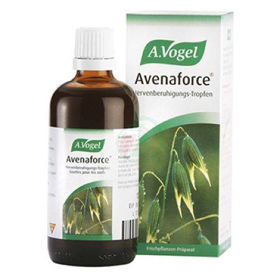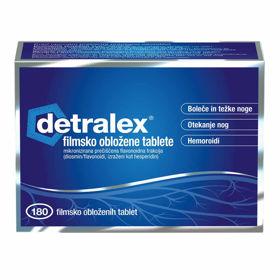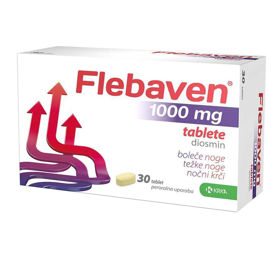Alfred Vogel's work is imbued with the principles of a healthy lifestyle and treatment in accordance with respect for nature. These principles grow into beliefs, as this is the only way they will be preserved for future generations.

Take care of your feet
Being successful in the profession and dynamic in their free time is difficult for many, as they are hampered by unpleasant foot problems resulting from improper functioning of the veins.
Every second woman and every fourth man suffers from these problems. Problems due to improper functioning of the veins initially manifest as tired, tingling feet, sore and swollen ankles, and varicose veins. Anyone who takes these first signs seriously can take timely action and slow down the progression of problems.
Signs of vein problems
Leg pain due to improper functioning of the veins does not occur overnight, but gradually. Therefore, we do not take these problems too seriously and treat signs such as varicose veins as aesthetic problems. Warning signs are tired and heavy legs after prolonged standing or sitting, swollen feet, too tight shoes in hot weather, and a pronounced imprint left by the elastic edge of the socks on the feet. As the problems progress, there may also be a feeling of tension, itching, tingling, night cramps in the hips, changes in the skin, varicose veins, swelling in the legs and inflammation of the veins. In extreme cases, this thrombosis (blood clot formation) can also occur, which can be a serious health risk.
When problems are worst
Vein problems are most noticeable if we stand or sit for a long time, but they improve if our legs are raised. Even warm weather exacerbates vein problems.
Who needs to be most careful
Overweight, prolonged standing or sitting, lack of physical activity, hereditary predisposition to weak connective tissues, chronic constipation and pregnancy are risk factors for venous problems. If your parents have or have had problems with their veins, you are more likely to have them as well. Age is also an important factor - the older we get, the more often we suffer from these problems.
Abdominal bloating (lifting, carrying, playing wind instruments, constipation and heavy strength training) has a bad effect on the veins. Smoking also causes damage to the venous walls and increases the chance of disease.
How veins work
About five liters of blood flows through our veins. When blood flows past the lungs, it is enriched with inhaled oxygen, and from there the heart pumps it out of the varicose veins. Oxygen-rich blood reaches the tissues through the arterial circulation, where it releases oxygen. Oxygen-free blood returns through the veins to the heart.
More than 80 percent of the blood is in the veins, so these veins are an important storehouse of blood. The function of the veins is also to regulate body temperature - if the outside temperature is too high, the surface area of the veins increases, thus cooling the body.
Veins have a difficult task in pumping blood. From all the veins that lie below the level of the heart, blood must flow upwards and overcome gravity. Three mechanisms help with this.
Muscle pump
Just as a wet piece of soap moves in the palm of your hand with the pressure of your fingers, so does the blood in the veins move due to the pressure of the muscles around them. The veins have thinner walls compared to the arteries and are wider, making them more susceptible to the pressure caused by the surrounding muscles. Their contraction puts pressure on the veins by pushing the blood upward toward the heart.
In a similar way, the nearby arteries also help, as their walls press lightly on the veins, pushing the blood in them upwards.
Valves
Every few inches, there are some kind of double-door valves in the veins that only open up and out - we call them valves. Their job is to take care of the proper direction of blood flow.
When the heart contracts so that it pushes the blood up, the valves open. At the break, however, they close, preventing the blood from returning downwards.
Breathing
inhalation and exhalation not only ensure that air enters the lungs, but also that venous blood returns to the heart through a hollow vein.
Diseases out - a problem for many
Diseases of the veins usually appear unnoticed, so we do not notice any signs in the initial stages.
An important property of the veins is the tension of their walls, which we call tone. It can be negatively affected by various factors, such as heredity or hormones (when taking birth control pills or during pregnancy).
If we are not physically active enough, the muscle pump also weakens, causing the veins to lose flexibility. This increases the pressure on the valves, which sooner or later no longer seal well. The blood therefore no longer flows continuously back towards the heart, but stagnates in the legs.
Due to the constant stagnation of blood, the walls of blood vessels become increasingly permeable, so the fluid and components of the blood pass into the tissue.
This causes swelling (edema), especially around the ankles, which first appears only in the evenings and eventually stays all day. This condition is called chronic venous insufficiency.
Signs of chronic venous insufficiency:
- Varicose Veins,
- swelling in the ankle and shin area, W tired and sore feet,
- feeling of heaviness in the legs
- tension and cramps in the joints,
- itching.
Varicose Veins
In addition to the veins that lie deep in the muscles, we also know the superficial veins, which are noticeable through the skin in some places. These veins are not very important for blood flow, as 90 percent of the blood flows to the heart through deep veins. Excessively dilated superficial veins are called varicose veins.
Ulcers on the legs
If chronic venous insufficiency lasts longer, skin problems such as dryness, redness, itching, brown spots, inflammation of the skin, and hardening of the subcutaneous tissue may occur. A serious complication of chronic venous insufficiency is an ulcer on the legs that can become infected - this is especially dangerous in the elderly. at these signs, the doctor should immediately investigate the cause and begin treatment.
Blood clots
Thrombosis or blood clotting which can be a dangerous complication of chronic venous insufficiency.
It is less dangerous if a clot occurs in the superficial veins. This is recognized by a feeling of heat and redness and swelling accompanied by a strong sensitivity to pressure.
However, the appearance of a clot in the deep veins can seriously endanger our health, although it can happen that we do not feel pronounced warning signs on the outside. Our feet may swell, or we may not even feel any signs. If the blood carries the clot forward through the circulation to the arteries, a life-threatening complication called a pulmonary embolism can occur. Prolonged lying down or sitting (for example in a car or on a plane), smoking and taking birth control pills increase the risk.
Treatment
There are several different ways to treat chronic venous insufficiency.
Your doctor may prescribe treatment with compression stockings that compress the veins, thereby speeding up blood circulation and lowering the pressure in the veins. By squeezing out the valves again work more properly and direct the blood upwards towards the heart, thus reducing swelling and preventing ulcers on the skin. Compression stockings vary in the strength of the material from which they are made. Tighter socks put more pressure on the veins, so we use them in advanced disease. The doctor who prescribes compression stockings decides on the most suitable strength.
Compression stockings should be worn every day, even during sports activities. They should be worn immediately in the morning when the feet are not yet swollen. Wearing these socks will alleviate the problems but will not eliminate their cause. In addition, many find these socks uncomfortable.
An effective method of treatment is to take the drug with the extract of the seeds of the common wild chestnut. You will learn more about this below.
In severe forms of chronic venous insufficiency, the doctor may also opt for more complex procedures. He can inject substances into varicose veins that heal damaged venous walls. However, surgery can remove damaged superficial veins. Usually this is not a problem for venous circulation as the blood finds its way through other veins back to the heart.
Common chestnut - a remedy for your veins
For mild and moderate problems due to chronic venous insufficiency, nature offers us effective treatment.
The most researched medicinal plant for the treatment of chronic venous insufficiency is the common wild chestnut. Medicinal ingredients contain its seeds.
Common chestnut acts on several causes of problems due to chronic venous insufficiency at the same time:
~ reduces the accumulation of fluid in the tissues, thus reducing swelling,
~ reduces the permeability and fragility of capillaries (smallest veins), ~ strengthens loose veins,
~ inhibits inflammation.
There is currently only one tablet available in Slovenia that contains an extract from the seeds of the common wild chestnut - A. Vogel venaforce.












 Facebook
Facebook
 Instagram
Instagram
 info@moja-lekarna.com
info@moja-lekarna.com

